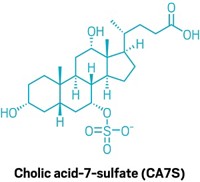Advertisement
Grab your lab coat. Let's get started
Welcome!
Welcome!
Create an account below to get 6 C&EN articles per month, receive newsletters and more - all free.
It seems this is your first time logging in online. Please enter the following information to continue.
As an ACS member you automatically get access to this site. All we need is few more details to create your reading experience.
Not you? Sign in with a different account.
Not you? Sign in with a different account.
ERROR 1
ERROR 1
ERROR 2
ERROR 2
ERROR 2
ERROR 2
ERROR 2
Password and Confirm password must match.
If you have an ACS member number, please enter it here so we can link this account to your membership. (optional)
ERROR 2
ACS values your privacy. By submitting your information, you are gaining access to C&EN and subscribing to our weekly newsletter. We use the information you provide to make your reading experience better, and we will never sell your data to third party members.
Microbiome
Small molecule could help modulate the microbiome
An inhibitor of starch-digesting enzymes stunts the growth of certain gut bacteria
by Jyoti Madhusoodanan
May 16, 2018

Hundreds of microbial species inhabit the human gut and support digestion, immunity, and other functions. Changes in their populations have been linked to diabetes, asthma, cancers and many other diseases. But so far, the complexity of microbial communities has made them impractical targets for controlling disease. Now, researchers report that a small molecule can block a type of common gut bacteria from consuming starch, which slows their growth. The results could offer a way to manipulate the bacteria’s proportions in the gut microbiome—a strategy that could eventually help researchers understand the microbiome’s role in health (ACS Chem. Biol. 2018, DOI: 10.1021/acschembio.8b00309).
So far, researchers have tried to tweak human and animal microbiomes with nutritional supplements, probiotic cocktails, or fecal transplants laden with microbes from other individuals. But small-molecule-based approaches have rarely been attempted: Common antimicrobial drugs wipe out a broad range of species, so they can’t be used to precisely edit a microbial community.
Organic chemist Daniel C. Whitehead and microbiologist Kristi Whitehead of Clemson University and their colleagues teamed up to find a more subtle approach that would manipulate selected members of the gut microbial community. The researchers homed in on Bacteroides, which represent more than half of the human gut microbiome and consume dietary starch and complex sugars. At least one study has shown that, compared to healthy individuals, patients with type 1 diabetes have a higher proportion of certain Bacteroides species in their gut microbiome before the onset of disease symptoms (Front. Microbiol. 2014, DOI: 10.3389/fmicb.2014.00678).
In the new study the team looked at two species of Bacteroides whose starch utilization pathways had been particularly well characterized. With these strains they tested three small molecules that inhibit human starch-digesting enzymes for their ability to act on bacterial enzymes. In laboratory cultures containing a variety of sugars, one of the molecules, acarbose, prevented Bacteroides species from consuming potato starch and fungal pullulan, a starch used as a common food additive. Acarbose did not kill the microbes or block them from digesting other sugars such as glucose.
On other sugar sources, the molecule had little impact on Bacteroides growth. But when the starch-derived polysaccharide pullulan or potato starch were the only foods provided, acarbose shut down the growth of Bacteroides. It did not affect Ruminococcus, another common gut inhabitant, even though this species also metabolizes starch.
In these initial experiments the researchers tested the bacteria in individual, lab-grown cultures. Therefore, it remains to be seen whether the human gut microbiome will respond in the same way. “But the results show that the system is targetable, which itself is quite significant,” says organic chemist Herman O. Sintim of Purdue University, who was not involved with the study.
“In the gut, it’s unlikely that only starches are going to be present,” says Kristi Whitehead, but acarbose would give Bacteroides fewer carbohydrates to choose from on the bacterial buffet. “In that highly competitive environment, that should reduce their growth.”
Advertisement
The researchers plan to extend their experiments to mixed bacterial cultures and animal models. “This work is really a proof of concept that a small molecule can arrest the starch utilization system,” says Daniel Whitehead.
So far, it’s not clear whether changes to the gut microbiome cause illness or are merely correlated to disease conditions. For instance, when Bacteroides flourishes before the onset of type 1 diabetes, the bacterial bloom could result from underlying metabolic changes or cause them. Blocking a metabolic pathway such as starch digestion might help prevent that early proliferation, and could serve as “a tool to actually answer that question,” Sintim says.
CORRECTION: This story was updated on May 18, 2018, to clarify that cells in the experiments described were fed only one sugar source at a time.




Join the conversation
Contact the reporter
Submit a Letter to the Editor for publication
Engage with us on Twitter